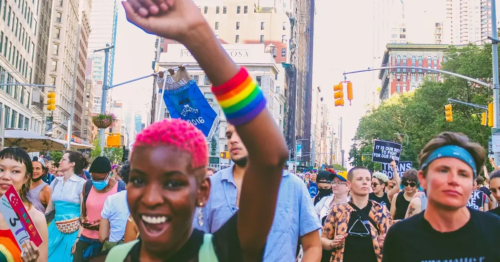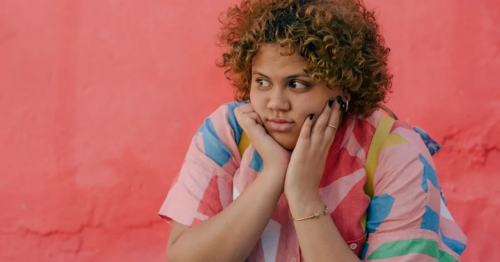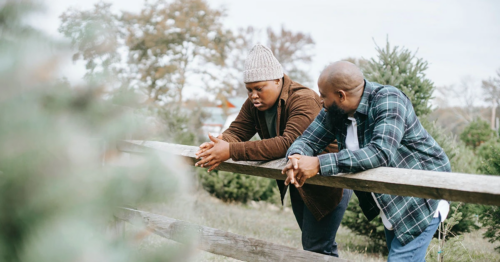
Table of Contents
Teen LGBTQIA+ Intimate Partner Violence: Know the Signs

Written By: Alex Bachert, MPH
May 25, 2022
6 min.
Although often less talked about, the LGTQIA+ community experiences a high rate of partner violence. We review six forms of intimate partner violence among teens.
Learn more about our Clinical Review Process
Table of Contents
Intimate partner violence is becoming more commonplace among teens and young adults in the U.S., and the LGBTQIA+ population is certainly no exception.
For anyone who not familiar with the term, LGBTQIA+ stands for the following: Lesbian, Gay, Bisexual, Transgender, Queer or Questioning, Intersex, Asexual, as well as any other sexual orientation or gender identity along the vast spectrum of sexual and gender identities.
Most research on teen dating violence doesn’t specify sexual orientation or gender identity, but some studies suggest that gay, lesbian, and bisexual youth are at a greater risk for dating violence compared to students who identify as heterosexual. Interestingly, that same study found that transgender and female youth are at the highest risk of victimization, but are also the most likely perpetrators of all forms of dating violence except sexual coercion. Research also suggests that the rates of intimate partner violence might be higher among transgender individuals compared to non-transgender youth.

Source: National Coalition of Anti-Violence Programs
While our article today focuses on teens and adolescents, it’s worth noting that LGBTQIA+ partner abuse can happen at any age. According to the 2010 National Intimate Partner Violence and Sexual Violence Survey, 61 percent of bisexual women, 44 percent of lesbian women, 37 percent of bisexual men, and 26 percent of gay men will experience abusive relationships at some point in their lives.
Charlie Health believes that everyone has the right to a respectful relationship, so we’ve outlined common types of teen dating abuse, issues that are specific to LGBTQIA+ relationships, and how to seek support if you’re currently a victim of LGBTQIA+ adolescent dating violence.
Six common types of relationship abuse
Teen dating violence is a type of intimate partner violence between two young people who are in a relationship or who were formerly together. It’s defined as a pattern of behavior that’s used to maintain power and control over an intimate partner, and it can occur in person or online.
There’s no one specific behavior that makes a relationship unhealthy or abusive, but there are certain red flags to look out for. Six types of relationship abuse reported in teen partnerships are physical abuse, sexual abuse, psychological abuse, digital abuse, financial abuse, and stalking.
According to a study of nearly 4,000 7th-12th graders in New York, Pennsylvania, and New Jersey, teen relationship abuse is most common among LGBTQIA+ youth.
- 43 percent of LGBTQIA+ youth reported being victims of physical dating violence versus 29 percent of non-LGBTQIA+ youth
- 23 percent of LGBTQIA+ youth reported sexual coercion versus 12 percent of non-LGBTQIA+youth
- 59 percent of LGBTQIA+ youth reported emotional abuse from a dating partner versus 46 percent of non-LGBTQIA+ youth
- 37 percent of LGBTQIA+ youth reported cyber or phone abuse and harassment versus 26 percent of non-LGBTQIA+ youth
Red flags in LGBTQIA+ Relationships
In addition to those common forms of adolescent dating violence, there are other specific behaviors to be mindful of in LGBTQIA+ relationships.
- Pressuring someone to come out or threatening to out someone before they are ready
- Using someone’s gender identity or sexual orientation against them
- Claiming that abuse is a “normal” part of a LGBTQIA+ relationship, or that certain actions can’t be abuse because it’s between LGBTQIA+ individuals
- Restricting someone’s access to medical treatment or creating barriers to receiving care; for example, canceling someone’s doctor appointment or hiding their hormones
- Mocking someone’s chosen pronouns or making fun of how their body looks compared with their gender identity
- Claiming that someone’s actions don’t match their identify; for example, saying to a lesbian female, “you’ve had relations with a man so you’re not really a lesbian”
Barriers to receiving help in abusive relationships
Everyone deserves to be in a safe, healthy, and respectful relationship, but research shows that LGBTQIA+ teens are less likely than non-LGBTQIA+ teens to ask for help due to perceived obstacles.
Fear
Some LGBTQIA+ teens might be hesitant to confide in teachers or seek support from law enforcement because of fear of discrimintation or mistreatment for who they are. Others might fear that broadcasting their abuse will detract from any positive progress in the LGBTQIA+ movement. Worries about homophobia, transphobia, and queerphobia should never prevent teens from sharing their story and asking for help to leave an abusive situation.
Shame
Admitting to being in an abusive relationship can be difficult. Feelings of shame and embarrassment, or even thinking you’ve done something wrong or deserve the abuse, can be common. But remember, blame-shifting is actually a common tactic used in intimate partner violence (also known as gaslighting). Being on the receiving end of jealousy, threats, and anger can influence the way you process a relationship, but teen dating abuse is never your fault.
Lack of LGBTQIA+ resources
Charlie Health prioritizes LGBTQIA+ care, but the same can’t be said for all healthcare providers, educators, support organizations, and law enforcement units. Not everyone is educated on issues specific to LGBTQIA+ relationships and this lack of knowledge can be a real barrier to feeling comfortable enough to seek care. For example, LGBTQIA+ education in schools is a controversial topic right now and not all staff and administrators are equipped with the cultural competency to help teens navigate partner violence of this nature. A similar dichotomy can be seen among healthcare professionals, including mental health providers, where there’s still work to be done in ensuring that all providers have sufficient knowledge to treat the LGBTQIA+ population with respect and accuracy.
Mental Health Effects of Unhealthy Relationships
Intimate partner violence is associated with an increased risk for suicidal thoughts and behaviors—something that’s already more prevalent in the LGBTQIA+ youth community compared to their non-LGBTQIA+ peers.
Results from the Trevor Project’s 2022 National Survey on LGBTQ Youth Mental Health found that 45 percent of LGBTQ youth thought about attempting suicide in the past year, including more than half of transgender and nonbinary youth. Further research from the Trevor Project noted that LGBTQ youth who experienced physical dating violence in the past year were even more likely to report a suicide attempt in the past year. Another recent study found that bisexual youth in grades 9-12 who experienced teen dating violence of any kind have an increased risk of suicide.
Aside from suicidal ideation, dating violence can have other lasting mental health effects for teenagers and young adults. Teens who are victims of dating abuse are more likely to be depressed, develop eating disorders, and perform poorly in school, as well as show an increased risk for abusing drugs and alcohol.
Mental Health Resources for LGBTQIA+ Youth
Whether you’ve already left an abusive relationship or you’re building the courage to end it, consider speaking with a counselor or therapist for professional mental health support. Connecting with providers and a community that understands the nuances of LGBTQIA+ relationships can provide you with the resources, support, and tools to leave a situation that’s no longer serving you.
If you find yourself in need of immediate support, please know there are organizations dedicated to helping you safely navigate scary situations. The following helplines are always available for immediate support.
- Love Is Respect Helpline: Call 1-866-331-9474
- National Domestic Violence Hotline: Call 1-800-799-7233
- The Anti-Violence Project: Call 212-714-1141
- National Suicide Prevention Lifeline: Call 988 or text the Crisis Text Line: HOME to 741741
LGBTQIA+ Support with Charlie Health
Everyone—regardless of age, gender, sexual orientation, or gender expression—deserves a healthy relationship in which they’re treated with respect.
Charlie Health offers virtual mental health treatment for adolescents, young adults, and families experiencing mental health crises. Our intensive outpatient program (IOP) provides trauma-informed specifically for LGBTQIA+ teens to help you build resilience and start healing. No matter where you are in the journey, our compassionate and experienced mental health professionals will provide a safe place for you to connect, heal, and grow.
References
https://link.springer.com/article/10.1007/s10964-013-9975-8
https://www.cdc.gov/violenceprevention/pdf/nisvs_report2010-a.pdf
https://www.charliehealth.com/post/love-is-respect-teen-dating-violence-awareness
https://avp.org/wp-content/uploads/2017/04/2015_ncavp_lgbtqipvreport.pdf
https://www.loveisrespect.org/pdf/LBGTQ_Abusive_Relationships.pdf
https://www.womenagainstabuse.org/education-resources/learn-about-abuse/lgbtq-relationships
https://www.charliehealth.com/resources/lgbtqia-resources
https://www.nami.org/Your-Journey/Identity-and-Cultural-Dimensions/LGBTQ
https://www.cdc.gov/mmwr/volumes/69/su/su6901a3.htm
https://www.thetrevorproject.org/survey-2022/
https://pubmed.ncbi.nlm.nih.gov/32571755/
https://www.canr.msu.edu/news/dating_violence_has_long-term_consequences_for_teens
https://www.charliehealth.com/how-it-works





